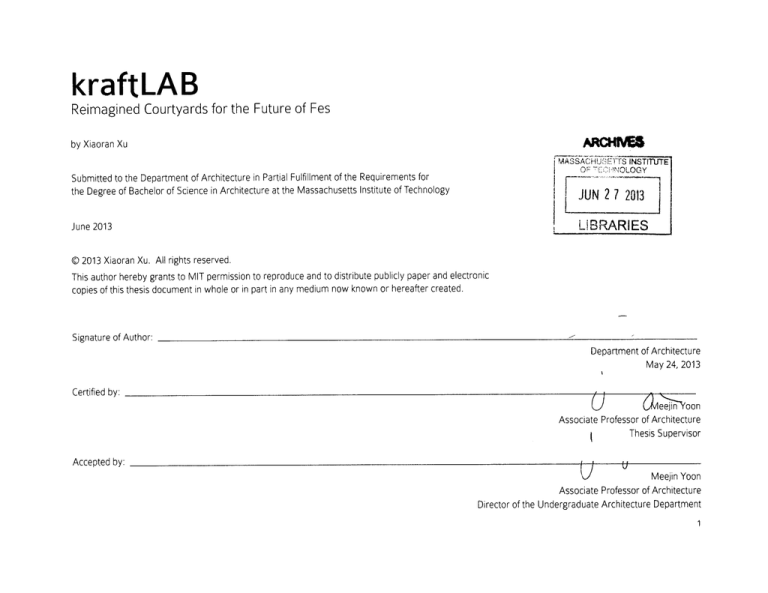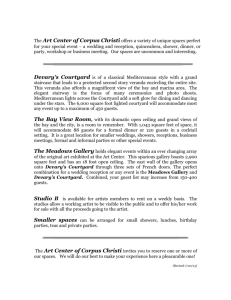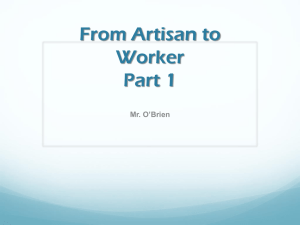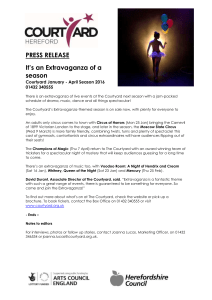
kraftLAB
Reimagined Courtyards for the Future of Fes
by Xiaoran Xu
MASSACHU:SETTS INSTITUTE
oZT CNNLOGY
Submitted to the Department of Architecture in Partial Fulfillment of the Requirements for
the Degree of Bachelor of Science in Architecture at the Massachusetts Institute of Technology
JUN 2 2013
L 'BRARIES
June 2013
V 2013 Xiaoran Xu. All rights reserved.
This author hereby grants to MIT permission to reproduce and to distribute publicly paper and electronic
copies of this thesis document in whole or in part in any medium now known or hereafter created.
Signature of Author:
Department of Architecture
May 24, 2013
Certified by:
U
Oeejin
oon
Associate Professor of Architecture
Thesis Supervisor
Accepted by:
Meejin Yoon
Associate Professor of Architecture
Director of the Undergraduate Architecture Department
1
THESIS COMMITTEE
Advisor
Meejin Yoon
Associate Professor
Department of Architecture
Reader
Cristina Parreno Alonso
Lecturer
Department of Architecture
2
kraftLAB
Reimagined Courtyards for the Future of Fes
by Xiaoran Xu
Submitted to the Department of Architecture on May 24, 2013 in Partial Fulfillment
of the Requirements for the Degree of Bachelor of Science in Architecture
ABSTRACT
Inthe urban labyrinth of Fes el-Bali, artisans toil away passionately in their courtyard houses that, with
the increasing density of the medina over the past century, have come to dominate the surrounding
architectural landscape. The homogenous typology of these riads presents a barrier to the interactions
between local artisan and visiting consumer. As a result, today's craft economy is largely centered
around the middleman merchant, further distancing the artist from the tourist.
This thesis explores spatial reimaginings of the Moroccan courtyard through a novel architectural program: the kraftLAB. Through this experimental crafting laboratory, the processes of craft production and
consumption are reconceptualized as a hybrid experience of artisan-tourist interaction, facilitated by the
reimagined sectional courtyard. This project proposes the development of an artisan network of kraftLAB architectures for the four main crafting trades of the medina (wood, metal, leather, and clay) that
assimilate into the figure-ground of the surrounding medina to help structure the informal craft economy
and mediate the connection between craftsmanship and consumerism.
Thesis Supervisor: Meejin Yoon
Title: Associate Professor of Architecture
3
ACKNOWLEDGEMENTS
To Meejin, thank you for the challenges, the guidance, and the encouragement all along the way.
To Cristina, thank you for your insightful critiques and refreshing enthusiasm.
To my studiomates, thank you for lending a helping hand.
To my family, thank you for your unending support of my architectural endeavors.
To the artisans of Morocco, thank you for sharing your stories with me and inspiring this thesis.
4
CONTENTS
Introduction: THE STORY OF FES EL-BALI
07
ii
Background: A CRAFT ECONOMY
11
iii
Site Analysis: COURTYARD TYPOLOGIES
15
iv
Proposal: THE KRAFTLAB NETWORK
21
v
Design: REIMAGINED COURTYARDS
25
vi
Bibliography
51
5
------- --m_-
n
I
N
-s
I
I
'1
1*~
I
ILI0
Sa
6
INTRODUCTION:
THE STORY OF FES EL-BALI
In the 9th century, the imperial city of Fes was founded on the banks of
the Jawhar river in Morocco. To protect their precious capital, the rulers
of the Idrisid Dynasty built a five-mile wall around the medina, but despite
these fortifications, political turmoil ravaged the city. During this turbulent
history, Fes' capital status remained in flux as control of the medina shifted
continuously from empire to empire, until finally at the beginning of the 20th
century, its status as political capital was permanently revoked and the city
The artisans of Fes el-Bali toiled away passionately within the city walls,
littering the city with their creations of wood, metal, hide, and clay. Crafting only for themselves, the artisans were free to create and manipulate
material to their heart's content. Only when they could craft no more did
they regretfully relinquish their beloved trades, passing them on to aspiring
generations.
was abandoned by all political powers.
Eventually the city itself began to grow as organically as the crafting trade.
Each new building was its own masterpiece of craft and skill, uniquely
With the medina thus neglected, a community of Andalusian artisans
distinct from all others that came before and never again to be replicated.
Slowly, from the ruins of the abandoned capital, an ad-hoc skyline of architectural crafts rose over the land.
sought refuge within its walls. Bringing with them a culture of intricate art
and crafts, the artisans transformed the ancient walled medina into a niche
of their own.
7
A
8
As the years went by, an influx of immigrants flowed into the city, eager to
join this exclusive community, and timeworn artisans taught their trade to
all who came. Bounded by the ancient walls, the medina grew inwardly,
condensing until it reached a swelling density of over 1,000 inhabitants/
hectare. Overwhelmed by this uncontrollable growth, the artisans of Fes
el-Bali could no longer differentiate themselves from the masses; each new
craft had already been designed and each new building came to resemble
From time to time, travelers wander into the labyrinth, seeking the renowned crafts of the medina; but helpless to navigate the labyrinth's paths
by themselves, they follow the medina's many unofficial tour guides through
its jagged streets. Tired artisans avoid the dense, unnavigable streets,
preferring to labor in the shadows of their cramped riads, out of gaze of the
public eye, forced to rely on merchants to sell their wares.
its neighbors until eventually the riad, or courtyard building, emerged as the
And in this manner, the medina lives on, playing host to the inhabitants of
the figure and the inhabitantsof the ground with little hope of interaction
only remaining architectural form in the city.
between the two.
Today, Fes el-Bali is an urban labyrinth of stark, windowless riads and narrow, winding alleyways. It has become a directionless city of nearly all figure and no ground; yet the devoted artisans nevertheless choose to linger
By the end of the 21st century, the buildings of Fes el-Bali are stale from
centuries of existence. As the old city crumbles, a new city of kraftLABs
within its walls, carrying on the crafting traditions of generations.
emerges in its stead...
9
.............
...................
.. --- ","
"I::
..." I _. I'll 11.............
...............
-- - - -_-
KRAFTLAB ECONOMY
ARTISAN-CENTERED
INFORMAL ECONOMY
MERCHANT-CENTERED
U--
10
-----
..
.........
..........
%
.........
..
. ..............
BACKGROUND:
A CRAFT ECONOMY
The tradition of craftsmanship in Fes el-Bali has remained central to the
image and functioning of the city since its revival in the 20th century. In
fact,crafting has come to define the Fassi lifestyle, serving as the source
of income for over 75% of the medina population and thus making Fes the
unofficial craft capital of the country.
Despite this predominant industry of crafting in the medina, the craft trade
is still an informal economy for the people of Fes, with artisans relying
entirely on merchants to sell their creations. This has resulted in a lack
of direct dialogue between artisan and consumer as crafted products are
passed blindly from artisan to merchant to consumer in a linear, rigid process which centers itself around the middleman merchant. This economic
hierarchy simultaneously stifles the entrepreneurial spirit in artisans and
limits the freedom of choice in consumers.
The kraftLAB economy seeks to put control back in the hands of the artisans
and to provide the crafting industry with a more interactive, transparent
operation process. At the center of this proposed model lies the kraftLAB,
where artisans are free to promote their wares and tourist consumers are
free to sample them. The middleman merchants become peripheral to the
network, only existing to facilitate the selling/buying process once tourists
have interacted with the artisans.
Inthis way, the kraftLAB brings together artisans and tourists and fosters
between them an interaction which strengthens the connection between
craft and tourism, the two main economic industries of the medina.
11
EXISTING CRAFT DISTRICTS
12
4
SELECTED KRAFTLAB SITES
13
LOCATION
SHAPE
SITE
PLURALITY
IRREGULARITY
440-10M4
0n
0
14DooonaO on
rn
tai rl SA n
G30t*00
E
cn
0
_-_
14
0%4t%
1* 40
Q)
an
I
in
Q0
0* 4 V040
LI4r~re
* IV
CM 4f) M <>
0044M 1313 0
0
4to. .Eo
on
B
SITE ANALYSIS:
COURTYARD TYPOLOGIES
The traditional riad house features a two or three story courtyard space,
usually centered within the building but sometimes nearing the front of the
house, that is oriented parallel to the street. The geometric volume of the
courtyard is, in almost all cases, formed by a pure extrusion of a square or
rectangle. All of a riad's windows, doors, and balconies are inward-facing,
toward the interior courtyard rather than the building exterior. The original
reason for this was to support Islamic notions of privacy, particularly for
A close analysis of riads in various sites within the medina identified the
spatial anomalies that exist within the riad typology and the prevalent
characteristics that are unique to each site. These localized traits were then
adapted to each selected kraftLAB site to create urban infill that assimilates
discreetly into the medina, in order to be undisruptive of the existing fabric.
Muslim women.
Today, in addition to dwelling, the riad has adopted the roles of shop, hotel,
restaurant, and even school, rendering meaningless the riad's designed
purpose of isolation and privacy. The medina has thus transformed into a
homogeneous urban fabric of courtyard buildings.
15
woodLAB
MULTIPLE COURTYARDS
.. .. .. .
Vbu3
16
SITE FIGURE
metalLAB
A,:
IRREGULAR COURTYARD
SITE FIGURE
17
leatherLAB
OPEN COURTYARD
LI-
18
SITE FIGURE
clayLAB
BROKEN COURTYARD
110%
004
SITE FIGURE
19
KRAFTLAB TYPOLOGY
POST-PRODUCTION
PRODUCTION
PRE-PRODUCTION
1111111 I-~
I IIIIIAIII
II
II
II
.A
por
It
materials storage
20
FABrication
handiCRAFT
artisan showroom
PROPOSAL:
THE KRAFTLAB NETWORK
kraftLABs are experimental laboratories of craft, technology, and consumerism. They serve as platforms of exchange for artisans and consumers to
interact within the medina. For artisans, they are communal workspaces
that emphasize experimentation over production, a reversion back to the
beginnings of the Fassi artisan community. For tourists, they are gallery
spaces that showcase not only each artisans' specialized crafts but more
importantly, the crafting process itself.
In an economy that remains largely unindustrialized, the artisans of Fes
el-Bali are slaves to the traditional modus operandi. kraftLABs introduce
mechanized techniques into the manual crafting process, but in contrast to
fab labs, they are not a complete overhaul of traditional crafting techniques.
Instead, they feature hybrid fab/craft processes that preserve the handmade
quality of the crafts while at the same time expediting the production process, which frees up time for artisans to devote to the creative exploration
of their craft rather than the intensive labor of production.
Each kraftLAB consists of four components that deal with the entire crafting
process, from pre-production - in the form of storage space for raw materials - to post-production - in the form of an artisan showroom that displays
finished works.
21
............
22
. .. .
......
.........
....
....
JOHN HEJDUK - BERLIN MASQUE
BERNARD TSCHUMI - PARC DE LA VILLETE
architectural characters scattered in an urban lot
ordered elements in an open park space
.........
. . .......
The dearth of architectural diversity within the medina results in a disorienting lack of urban organization, creating a barrier for artisans trying to
showcase their crafts.
The establishment of an artisan network of kraftLABs in the medina locates
and organizes the primary craft industries into sectors, making the currently
dispersed craft production processes accessible to the consumer.
The network is formed from individual kraftLABs distributed at regular distances throughout the open spaces of the medina, creating a reliable system
of landmarks that help structure the informal craft economy.
Each kraftLAB exists as an architecturally distinct, idiosyncratic character in
an otherwise homogeneous landscape to help provide navigational cues in
the urban context.
23
...
........
. .....
24
DESIGN:
REIMAGINED COURTYARDS
In a city dominated by riads, where identical structures serve its every
function, the building becomes redundant, lacking spatial distinction and architectural value. The kraftLAB aims to defy the spatiality of the traditional
extruded courtyard building with experimental, contemporary reimagined
courtyards that sit counter to the eternal courtyard typology of the medina.
Unlike the isolated quality of the riad courtyard, the kraftLAB courtyard
promotes artisan-consumer interaction through its integrated spaces.
Each kraftLAB employs a different displacement or carving operation to
create novel solid-void relationships inspired by the surrounding typological
characteristics. Though the massing strategy for each kraftLAB is formally
distinct, they function similarly to produce two integrated paths of circulation - one for the artisan, one for the tourist.
25
'p
woodLAB
PROGRAM 8 TYPOLOGY:
The multiple courtyard typology is useful for the ventilation of wood dust in
confined woodworking spaces. The distribution of these mini-courtyards
encourages airflow throughout the building.
CIRCULATION STRATEGY:
In woodLABs, a central spine serves as the primary path of circulation.
Vertical displacements create secondary passages branching off from this
path to provide sectional entrances for each courtyard.
WOOD-CRAFTING PROCESS:
R-I I1
I I
I
-
4
26
q-i iii
I
l
ll
liii
I-h
MASSING STRATEGY:
TOURIST
ARTISAN
MODEL STUDIES:
4
27
metalLAB
PROGRAM 8 TYPOLOGY:
The irregular courtyard typology allows for the creation of interior courtyards that receive filtered light, which fits the need of metalworkers whoprefer lower-light conditions due to the high reflectivity of metal.
CIRCULATION STRATEGY:
In metalLABs, individual courtyards that appear separate from the exterior
are connected interiorly to form a continuous irregular courtyard. The circulation exists as two intertwined strands around the void of the courtyard.
METAL-CRAFTING PROCESS:
1111-p
q-i iii
III I-P
-w
-I1111
28
i-
I
I IIIIlilt
11ji
I I-h
III'
MASSING STRATEGY:
TOURIST
ARTISAN
MODEL STUDIES:
4
29
leatherLAB
PROGRAM 8 TYPOLOGY:
The open courtyard typology provides well-lit, open-air terraces that facili-
tate the drying of processed and colored leather hides and provide necessary ventilation for the pungent tanning process.
CIRCULATION STRATEGY:
In leatherLABs, a ground-level central courtyard gives access to two
elevated edge-yards at different levels. The circulation progresses in two
interlocking spirals from the central courtyard through the edge-yards.
LEATHER-CRAFTING PROCESS:
III F.N
i i l
30
'-liii
..
I.I.I.I.I.I.
IIIlll
ll
IlIllIllIl
MASSING STRATEGY:
ARTISAN
TOURIST
MODEL STUDIES:
31
dayLAB
PROGRAM 8 TYPOLOGY:
The broken courtyard typology accommodates the need for temperature/
shade regulation during the clay-crafting process by providing shaded exterior corridors for pottery-drying.
CIRCULATION STRATEGY:
In clayLABs, the primary circulation wraps around two sides of a central
courtyard, with displaced solids forming the other two sides. Each displacement creates a sectional void that becomes an extension of the courtyard.
CLAY-CRAFTING PROCESS:
MLitii
III I-_
%-1III
q-i iii
I'll-
~
32
MASSING STRATEGY:
TOURIST
ARTISAN
MODEL STUDIES:
V
33
34
RELATIONSHIP BETWEEN KRAFTLABS AND SURROUNDING CONTEXT
"
%
,
do
DECOMPOSITION INTO TOURIST, COURTYARD, ARTISAN SPACES AND THE INTERFACES IN-BETWEEN
35
v15
disk-
36
LIGHTING STUDIES OF MORNING SUN
i
LIGHTING STUDIES OF AFTERNOON SUN
-,
37
..
.....
...........
CASESTUDY
38
metalLAB
SOA*~
A4
39
40
41
..
..
............
....
. .........
..................
::............................
..........
::
......................................
...
. .........
:.
........
EXPLODED KRAFTLAB SHOWING TWO MATERIAL STRATEGIES:
42
transparent, solid glass walls for tourist-courtyard interface
opaque, porous wood slats for artisan-courtyard interface
GLASS ENCLOSURE
WOOD ENCLOSURE
.- R ",- " - " ,
I
-
--
- .. .- -
---
-
-
-
................................................................
- - - -- -, -
---
I,- ,,,- I-
-,
..................
...................
....................
..
...........
FINAL MODEL PHOTOS
44
ARTISAN SPACE
TOURIST SPACE
45
:
.................
46
.................
49
50
BIBLIOGRAPHY
Baroudi, Mokhtar. P/an de Fes. Map. Marrakech:
Gdtions Glite
Et Tourisme, 1978.
Chaouni, Aziza. Hybrid Urban Sutures: Filling in the Gaps in the Medina of Fez. <http://www.azizacha
ouniprojects.com/wp/#url=/wp/2012/11/fez-infills-hybrid-urban-sutures/>.
Hejduk, John, and Kim Shkapich. Mask of Medusa: Works, 1947-1983. New York: Rizzoli, 1985.
"Medina of Fez." UNESCO World Heritage Centre. <http://whc.unesco.org/en/list/l 70/>.
"Morocco Compact." Millennium Challenge Corporation. <http://www.mcc.gov/pages/countries/err/
morocco-compact>.
Newcomb, Rachel. Women of Fes: Ambiguities of Urban Life in Morocco. Philadelphia: University of
Pennsylvania, 2009.
Pfeifer, GOnter, and Per Brauneck. Courtyard Houses: A Housing Typology. Basel: Birkh user, 2008.
Rabbat, Nasser 0. The Courtyard House: From Cultural Reference to Universal Relevance. Farnham,
Surrey, England: Ashgate, 2010.
Revault, Jacques. Palais Et Demeures De Fes. Paris: Editions du Centre Nationale de la Recherche
Scientifique, 1989.
51
52






